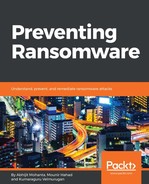Book Description
Your one-stop guide to know digital extortion and it's prevention.
About This Book
- A complete guide to how ransomware works
- Build a security mechanism to prevent digital extortion.
- A practical approach to knowing about, and responding to, ransomware.
Who This Book Is For
This book is targeted towards security administrator, security analysts, or any stakeholders in the security sector who want to learn about the most trending malware in the current market: ransomware.
What You Will Learn
- Understand malware types and malware techniques with examples
- Obtain a quick malware analysis
- Understand ransomware techniques, their distribution, and their payment mechanism
- Case studies of famous ransomware attacks
- Discover detection technologies for complex malware and ransomware
- Configure security software to protect against ransomware
- Handle ransomware infections
In Detail
Ransomware has turned out to be the most aggressive malware and has affected numerous organizations in the recent past. The current need is to have a defensive mechanism in place for workstations and servers under one organization.
This book starts by explaining the basics of malware, specifically ransomware. The book provides some quick tips on malware analysis and how you can identify different kinds of malware. We will also take a look at different types of ransomware, and how it reaches your system, spreads in your organization, and hijacks your computer. We will then move on to how the ransom is paid and the negative effects of doing so. You will learn how to respond quickly to ransomware attacks and how to protect yourself. The book gives a brief overview of the internals of security software and Windows features that can be helpful in ransomware prevention for administrators. You will also look at practical use cases in each stage of the ransomware phenomenon. The book talks in detail about the latest ransomware attacks involving WannaCry, Petya, and BadRabbit.
By the end of this book, you will have end-to-end knowledge of the trending malware in the tech industry at present.
Style and approach
The practical end to end guide which helps security administrators, security analysts, or any stakeholders in the security sector to learn about ransomware attack and its prevention.
